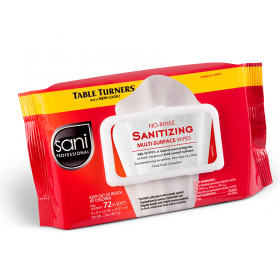



Cleaning, Sanitizing & Disinfecting
What's the Difference?
DISINFECTING – Disinfecting is the elimination of pathogens and disease-causing microorganisms.1
Clean the surface before sanitizing it! Only when a surface is properly cleaned can it be effectively sanitized. Cleaning is removal of all organic matter, including food debris, liquids, food residues (such as oil and grease) from a surface. Leaving behind any type of contaminate can not only allows for bacteria to grow but also prevents sanitizers from coming in direct contact with the surface needing to be sanitized. It is vital that proper cleaning be performed prior to any sanitizing procedure.1
Effective sanitizing of cleaned surfaces reduces the presence of potentially harmful microorganisms, rendering surfaces safe for food contact. This is critical since germs on surfaces are easily transmitted to hands and vice versa, leading to cross-contamination and foodborne illness outbreaks. In foodservice environments, chemicals like chlorine, iodine, and quaternary ammonium are commonly used to sanitize food contact surfaces.1
In order to be Food Code compliant, sanitizers must be proven effective against E. coli and Salmonella typhi and be registered with the federal Environmental Protection Agency and each state’s EPA.
Some sanitizing protocols are more complicated than others. While all protocols require cleaning prior to sanitizing, rag and bucket methods used to sanitize can require careful measuring, mixing, and monitoring to ensure proper chemical concentration. Even when prepared correctly, organic material present in sanitizing solutions can potentially bind to the active agent, reducing the effectiveness of the sanitizer and allowing germs to survive. This can lead to cross-contamination.2
Premoistened wipes are an easy-to-use alternative that guarantee proper sanitizer concentration levels with every wipe while reducing training time as sanitizing wipes simplify protocols; eliminate bucket testing and the need for mixing and measuring.
Sanitizing Simplicity



